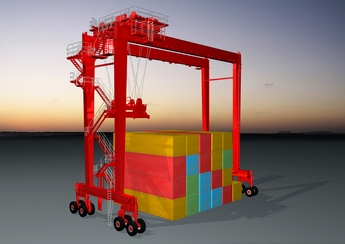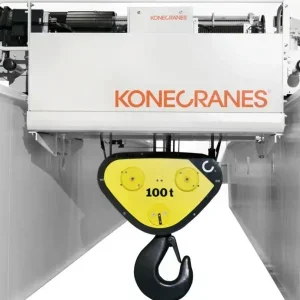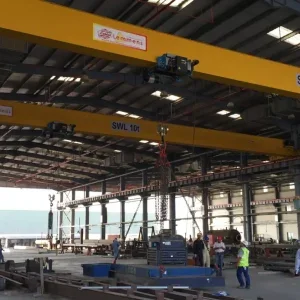Since the E-One’s launch in 2005, global sales have taken off, prompting Kalmar to update and redesign the machine – in accordance with customer feedback, it says – to further improve its serviceability and performance.

Kalmar says it is the first RTG manufacturer to give operators and technicians complete access to the cabin and trolley via a system of stairs, ‘making the trip less demanding and dangerous,’ it adds
To make the job of the service technicians easier and less stressful, some of the E-One+’s key components have been relocated to a position where they can be more easily serviced. For example, the emergency hoist stop sensor and spreader cable connection box have been moved to the level of the trolley platform to enhance convenience.
Kalmar says it is the first RTG manufacturer to give operators and technicians complete access to the cabin and trolley via a system of stairs, “making the trip less demanding and dangerous.” The stairs have been designed at a less than 45 degree angle, also improving safety.
The new cabin has been incorporated with more ergonomic considerations such as better all-around visibility, more space and an optional elevator. Cabin maintainability has also improved as its windows can be washed from within the cab or from cabin platforms.

Kalmar says its erection team will spend less time on the terminal affording the customer greater flexibility in managing operations
Less maintenance points
The new RTG has been engineered with maintenance-free propeller shafts and a trolley drive chain. These components do not require greasing, therefore relieving the service technicians of this burden.
The previous E-One RTG employed a festoon system to feed the trolley electricity. The design of the new E-One+ now incorporates a more reliable and efficient cable chain system which is maintenance free and quicker to install.
Its components have been adjusted and redesigned to facilitate easier, quicker connections during the erection process. Kalmar says its erection team will spend less time on the terminal affording the customer greater flexibility in managing operations.
Faster maintenance of the hoist ropes, which means better crane availability, is now possible. The new E-One+ RTG can be equipped with a small winch located on the trolley designed to help lift the ropes from ground to trolley level when they need to be serviced or replaced.
Anti-sway system
Also new from Kalmar is its new Max Stable anti-sway system, featuring an eight-rope reeving system without auxiliary ropes for faster, no-sway micromovements, thus making cycle times quicker and more efficient. Customers who choose the Max Stable anti-sway system for their RTG operation will “experience better load stability control due to the fact that all eight ropes are hoisting the spreader’s cargo,” according to the manufacturer.
Its design is comprised of a spreader attached to a more rigid rope reeving system by means of two hoist drums. A new angular sheave scheme has been developed that, in combination with the eight-rope design, naturally stabilises the load allowing faster, more accurate positioning of the spreader.
Rene Kleiss, vice-president of Kalmar Cranes, says: “Our customers have unique expectations of crane productivity, but many of them are seeking more efficient stacking movements and better lifting speeds with higher capacities for their operations.” He added: “The new Max Stable meets these needs as its rigid rope reeving system ensures stability because the main components [hoist ropes, drums and sheaves] are completely integrated.”






